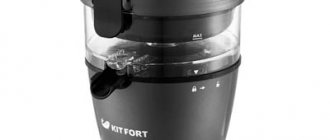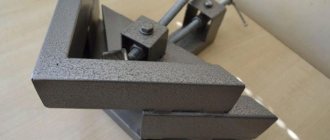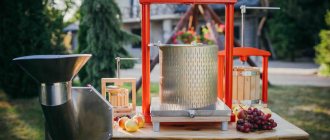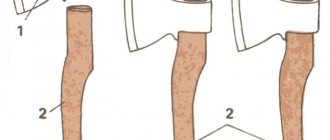Processing the harvest of berries and fruits is one of the most important tasks that not only farmers, but also owners of personal plots have to solve. Technical devices that greatly facilitate this process include a juice press, which allows you to quickly and without significant physical effort turn fruits and berries into tasty juice rich in vitamins. There is a wide variety of such devices on the modern market, but those home craftsmen who want to save money on purchasing them can easily make such a press with their own hands.
Extracting juice using a garden press
Variety of models
Different models used for squeezing juice are sold in stores. But they cannot cope with a large harvest. Often, summer residents make a juice press at their dacha with their own hands.
All presses used for squeezing juices are divided into four different types:
- mechanical, squeezing out juice under the influence of pressure, which is lowered manually;
- hydraulic type, but with manual drive;
- hydraulic models with electric drive;
- models with a pneumatic device, manual or electric drive.
Hydraulic
Mechanical
Pneumatic
Approximate prices
The cost of manual screw presses for squeezing juice directly depends on their capacity. The price for devices with a working volume of 10-15 liters ranges from 9,000 to 15,000 rubles. For a manual press that holds 25 liters of raw materials, you will have to pay at least 20,000 rubles.
The average price of home “juice squeezers” driven by a hydraulic jack is 19,000 rubles. A pneumatic press for squeezing juice from apples can be purchased for 34,000 rubles. For a membrane-type hydraulic device, sellers ask 94,000 rubles.
How to make a juice press
To manufacture any type of device, you almost always need the same set of tools:
- saws;
- different boards;
- steel corners;
- bolts and nuts;
- hammer;
- spanners;
- welding machine;
- wire cutters with pliers;
- strong fabric with filtering properties;
- stainless steel sheet or wooden planks.
The following elements may also be required from materials:
- metal beam (channel);
- blocks of wood or steel slats, boards;
- screws, bolts with nuts;
- stainless steel tank;
- steel screw with nut;
- faucet, threaded rod or jack;
- a piece of strong fabric with a drainage effect.
When manufacturing a squeezing apparatus from wooden parts, welding is not used.
The use of drainage grates ensures that high-quality juice is obtained from all layers of the prepared material. Fabric bags remove the liquid from the pulp. The most common are mechanical pressing devices, since they are the most affordable and simple in design. Hydraulic models are popular among them.
A press of any type consists of the following elements:
- base in the form of a frame;
- a building where bags of fruit are stored;
- grids for filter bags;
- piston;
- support for fixing the jack;
- special screw or car jack;
- container for the pallet.
Mechanical
If we judge the performance of devices, then for mechanical versions of devices it is small and does not exceed 30 l/h. In country conditions, this level of work speed is sufficient. This type of unit is the easiest to manufacture.
The basis of the structure, made independently, is the frame. It must be strong so that the jack leg resting on it does not cause it to deform. For the frame, it is better to use a steel pipe with a square or rectangular cross-section, the walls of which are 3 mm. The height of this frame is selected taking into account all the elements that make up the press.
Hydraulic
Models of such devices, made independently, must have sufficient technical characteristics to process the entire harvest.
For a hydraulic press, a jack is often used to create the required pressure. You can also use a membrane exposed to water supplied from a regular water supply. Expanding, it acts on the fruits collected in bags and placed in a drainage basket, squeezing out the juice. Through the holes in the walls, the juice flows into the sheet of the tray, and then into a substitute container.
The frame is made according to the same drawing as in a mechanical press.
For the body, sometimes they take an ordinary barrel, in which a hole is cut out at the bottom and equipped with a drain. An unsealed barrel is even better: the juice flows through the cracks into the pan in all directions. But in this design, a casing with a diameter larger than the barrel is put on, and drainage is made. Then all parts of the press structure are connected.
The body of the drainage basket can be made of wood, for which you take several identical planks, two steel strips, and self-tapping screws with a special coating. The planks are screwed to the strips, the strips are bent in a circle, and secured with bolts. The basket is ready. The distance between the slats is about 10 mm. The tray can be made from a plastic bowl with a hole cut out for drainage.
The support for the jack is made as follows:
- knock down wooden slats;
- cut out a circle from the resulting canvas with a diameter slightly smaller than the working body;
- If you have a piece of stainless steel, you can cut a circle out of it.
The jack is installed on this support plate. The result will be a device that resembles a press.
Screw
A fruit screw press is structurally similar to a meat grinder. In it, the electric motor is connected to the auger. It works like this: loaded prepared fruits are crushed by an auger, then pressed through a conical fine grid, which allows high-quality juice to be squeezed out. But it is impossible to make a juice press of this type on your own, unless you buy a special screw, similar in design to the screw of a meat grinder.
Screw mechanism
More often, summer residents strive to make a screw unit. However, it is impossible to make a screw without a turner, unless you use a regular car jack instead of a screw.
To obtain pressure inside the pressing device, a jack is installed at the bottom of the frame. The top of the lifting device's foot rests against the lower part of the thrust pad, which moves along the sides of the frame. As the jack lifts itself, it also lifts the support, which moves toward the piston located on the underside of the screw rod. This press is the most reliable for squeezing juices.
Then the lattice is assembled and a stand made of small beams is installed. A retainer for the pressure-creating part of the screw is secured on the top plate. The welded structure will be stable. A hole is cut at the top of the frame for a screw, which can be made by a lathe. The nut is welded to the frame.
The tray is made of a corrosion-resistant steel sheet, in which a spout is bent at the front to express the juice. Place a collecting container under the spout.
Combined type
In most models, pressure is applied to the fruit from above, but in this version of the unit it is carried out from two sides: from above using a screw device, from below using a hydraulic jack.
The device consists of the same elements as the models described above. But in this device, a screw device is installed on top, which exerts pressure from above on the drainage bags, and from below, a membrane filled with water from the water supply acts on the fruit.
Typically, the support for the jack in this mechanism is made of wood, as in the hydraulic version. This mechanism works most efficiently due to its bilateral influence.
Option using a jack
It is more convenient to use jacks for cars weighing 2-3 thousand kg instead of a screw. A nut for fastening is no longer required here, and a homemade press from a jack turns out to be more powerful. The only difference in the assembly is a durable frame that can withstand pressure. The jack is installed both from below and from above - it depends on the user’s preferences.
When the apparatus is ready, apples are placed in the container and a wooden circle is placed underneath. This will maintain the integrity of the structure at high pressure.
Average productivity - 1.75 liters of juice in 5 minutes.
The sequence of work for the manufacture of a simple pressing device
The elementary design of a mechanical press, which any summer resident can make, is made in the following sequence:
- A vessel of the required volume for the crushed mass is prepared. You can take an old drum from a broken washing machine. Holes are drilled on the walls of this drum with a drill, trying to arrange them in several lines, like pieces on a chessboard.
- There is a dish, somewhat larger than the previous one, but without a bottom. Additional holes are made in it on the wall below.
- The prepared dishes are inserted one into the other, and a wooden block of such thickness is placed between the walls to create the necessary gap between the walls of the vessels.
- A frame with a shape similar to a P is made from durable wood. A thick cast iron or steel circle is installed on the crossbar of this frame. It is fixed using an additional hole made inside the frame body.
- Both vessels are placed inside the large pelvis. They can take any basin, as long as it has a diameter larger than the main body and is made of polymer materials into which food products can be poured or placed. A hole is made in the bottom of the basin for a tube designed to drain the squeezed juice, and the tube itself is secured.
- The frame must be concreted, because it is the basis of the pressing mechanism. A structure assembled from a basin with a tube and vessels is then mounted on the frame body.
- Prepare a container to collect the liquid during spinning. The end of the tube, which was fixed in the bottom of the pelvis, is lowered into it.
Your homemade homemade press, the purpose of which is to squeeze out juice, is ready.
Stainless steel sheet blank with drilled holes
Bending the workpiece into a cylinder
The lower part of the frame is made of profile pipe
Top frame with screw nut
The press is almost ready, all that remains is to paint the frame
From an activator type machine
A centrifugal juicer can also be made from an activator-type washing machine. The activator and shaft are removed from the bottom of the tank, and a shaft of the required diameter is installed. Three knives are installed on the shaft thread with nuts at an angle of 60 degrees. The drain hole closes. A stainless steel mesh with a mesh size of approximately 1.5 mm is placed on the wall of the centrifuge with an overlap of 40-50 mm. A complete rubber cap, plugged with a stopper, is placed on the bottom. Everything is washed with baking soda. The timer relay is turned off or its toggle switch is jammed.
Several apples are dropped into the tank onto moving knives. The fruits are crushed for 20-30 minutes. At a time, transfer no more than 3 liters of the resulting puree into the centrifuge so that it does not spill out. After 2-3 minutes, the mesh containing the waste is removed.
The assembled apparatus prepares 10-12 liters of juice with pulp per hour and works with juicy fruits. To remove sediment, the juice is allowed to settle and then passed through cheesecloth.
How to make basic press parts
Initially, you need to prepare a metal base, then form the upper half of the frame, positioned horizontally. A very durable material with thick walls is selected for it, which will eliminate the deformation of the components under load. Corrosion can be prevented by treating the surface of the frame with paint. Then plywood is laid on the base, and a tank with a tray is installed on top. The plywood is varnished.
Pallet
If you make the press yourself, it is important to make the pallet correctly. Here they sometimes use a large pot, where a round hole is cut out near the side and a tube is secured. Through this tube, the juice will flow from the tray into the receiver. When working with the structure, you need to be careful. The tray may break if the tube, tray gets caught, or something is accidentally dropped on it. If you are not careful, you can tear out the tube. For this reason, it is preferable to choose a tray made of stainless steel, and weld a metal tube to the hole.
The tray can be made from a large plate or from a stand for a flower pot
Filters
Filters are bags in which the pulp is placed. The scraps of fabric that are needed to make bags of fruit must be durable. Suitable for this purpose: calico, cotton or burlap. Some people use linen. The density of the fabric should not reduce its filtration qualities, but it should not be fleecy.
To filter juice, you should use a durable cloth with a fine mesh, such as lavsan or polyester.
Drainage grate
A grid for drainage function in the form of a basket can be made from oak, birch or beech planks. Choose those whose thickness is 20 mm or more. To do this, take several identical planks, two steel strips, and self-tapping screws that have a special coating. The planks are screwed to the strips, the strips are bent in a circle, and secured with bolts. The basket is ready. The distance between the slats is about 10 mm. You should not take chipboard plates; such material will release resin, sawdust and other harmful substances into the juice.
To sew bags, use any durable fabric that will not tear under the pressure of the raw material. In addition, the fabric must have filtering properties.
Chopper
This part is a mandatory part of the presses, since their models work in conjunction with such a component of any pressing structure. The simplest among such grinding mechanisms is considered to be a steel grater drum, which is placed in a homemade casing with a hole for loading pulp. When you turn the handle, the chopper is set in motion, turning the fruits into pulp.
It is made from a sheet of moisture-resistant plywood, a sheet of anti-corrosion steel or wooden planks. The resulting hopper is mounted on a circular shaft. Two blocks are attached to the bottom of the bunker for stability. At the bottom of the resulting container, a roller of wooden material is inserted onto which self-tapping screws are screwed in a spiral. The axis of rotation of the element is brought out, and the drill is inserted into it. It will act as a chopping drum. To do this, you can use a regular rolling pin, which is found in every kitchen.
When making a model of a device for obtaining juice, you should pay attention to its stability. To cope with this problem, three pieces of square pipe are welded at the bottom of the frame. Instead of legs, they will give the unit stability. At the top of the improvised legs, a stand made of boards or a wooden slab is placed, where the pallet is placed.
You can independently make a press for high-quality extraction to obtain any juice without spending a lot of money or special skills, abilities or knowledge. The use of complex equipment is also not required.
Power element of the structure
Piston
Preparation of raw materials
The principle of squeezing apple juice
simple - the finer the raw materials are chopped, the more product will be obtained at the exit. It is best to use a special chopper (crusher), since finely chopping several buckets of apples by hand is theoretically possible, but in fact difficult to implement. An electric meat grinder for large volumes is also not an option: it roars, howls, gets hot, and may eventually burn out. You can also make a suitable crusher yourself.
The simplest design of a homemade crusher
A deep hopper is mounted lightly on the cone from moisture-resistant plywood or stainless steel sheet. For stability, two bars are attached to it from below. A wooden roller (preferably made of beech) with self-tapping screws wound in a spiral is cut into the lower part of the container. You can use a regular kitchen rolling pin as a drum.
. The axis of rotation of the roller comes out, a drill is inserted into it and the process begins.
Some people simply crush apples in a bucket using a construction mixer.
Popular manufacturers
The Russian market mainly presents models from domestic and Chinese companies. The latter are usually made of stainless steel. There is a fairly high risk of purchasing a product that will react with acids and add an unpleasant taste to the final product, so it is better to choose a juice press from Russian manufacturers.
| Firm | Peculiarities | Popular models |
| Farmer | Uses modern technologies to produce equipment for processing agricultural products | SVR-01M made of stainless steel - capacity up to 15 l/h, manual control. Additionally used for pressing homemade cheeses and obtaining wax |
| Magarych | The main task is to protect the population from counterfeit alcohol through the production of products for the production of high-quality homemade alcohol | SPM 15 - the main characteristics are the same as the previous model. You can also use it to compress meat. |
| Fork | Manufactured according to European standards, the product line includes not only press juicers, but also choppers, shredders, cheese factories and much more | Muromets P differs from its predecessors in productivity (30 liters per hour) and control system (pneumatic drive) |
| Good heat | They are engaged in the production of goods for moonshine and brewing, canning, and winemaking. We started as a small company, but in seven years we turned into a large plant | In addition to stainless steel, the product uses rubber and brass. Suitable for large production volumes (productivity up to 100 liters per hour). Operates hydraulically and has a pressure relief valve |
European companies are also represented on the Russian market, but you need to take into account that if parts break down, it will be more difficult to purchase spare parts.
Good heat
Magarych
Farmer
Fork
Conclusion
To make delicious homemade juice, it is not always advisable to purchase a juicer or a branded mechanical apple press. The price of such units does not always justify the frequency of their use, because not every year produces a rich harvest.
With basic skills in using tools, desire and time, it is quite possible to independently assemble a homemade household manual juice press.
The video in this article clearly shows all the intricacies of the assembly process of this unit. And if you have your own ideas and thoughts on this matter, I welcome your comments below.
Processing the harvest of berries and fruits is one of the most important tasks that not only farmers, but also owners of personal plots have to solve. Technical devices that greatly facilitate this process include a juice press, which allows you to quickly and without significant physical effort turn fruits and berries into tasty juice rich in vitamins. There is a wide variety of such devices on the modern market, but those home craftsmen who want to save money on purchasing them can easily make such a press with their own hands.
Features and principle of operation
The operation of such a device is based on the use of strong pressure to extract juice from fruits or berries (apples, grapes, plums and apricots, citrus fruits, and other fruits). Although different models differ in the type of control and complexity, they always consist of several required parts:
- basket for raw materials;
- juice tray;
- filter;
- press that creates pressure.
There is still no exact information whether this design is a type of juicer or whether they are two different devices for similar purposes. Most often, such devices are called press-type juicers.
Basically, a juicer press is used to extract juice. The device is suitable for any fruits and vegetables, with the only caveat - the harder the fruit, the more it needs to be crushed beforehand, and the more effort it will take to obtain juice. However, all efforts will be justified - the final product retains the maximum amount of minerals and vitamins. In addition, even the simplest press models are easy to use. A household appliance can be useful at home or in the country, and large, complex types of products are actively purchased by factories and farms.











